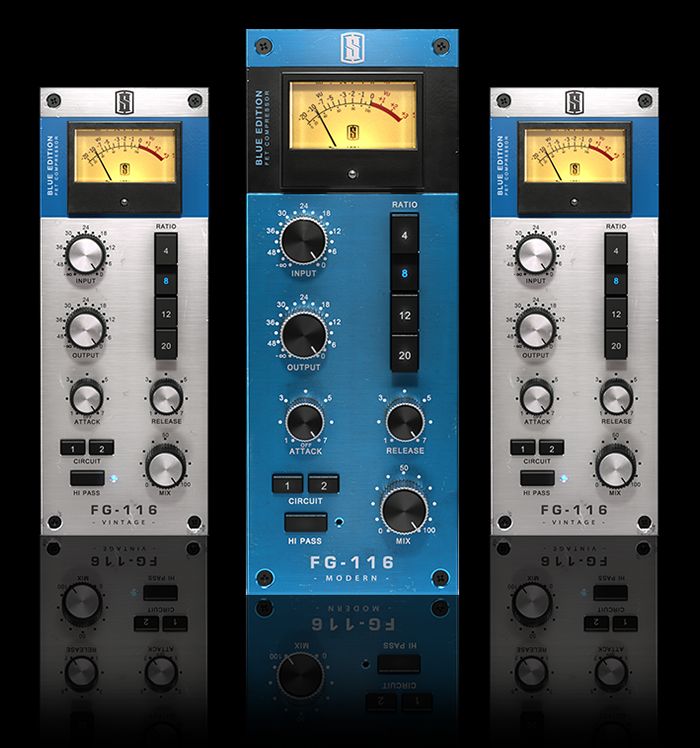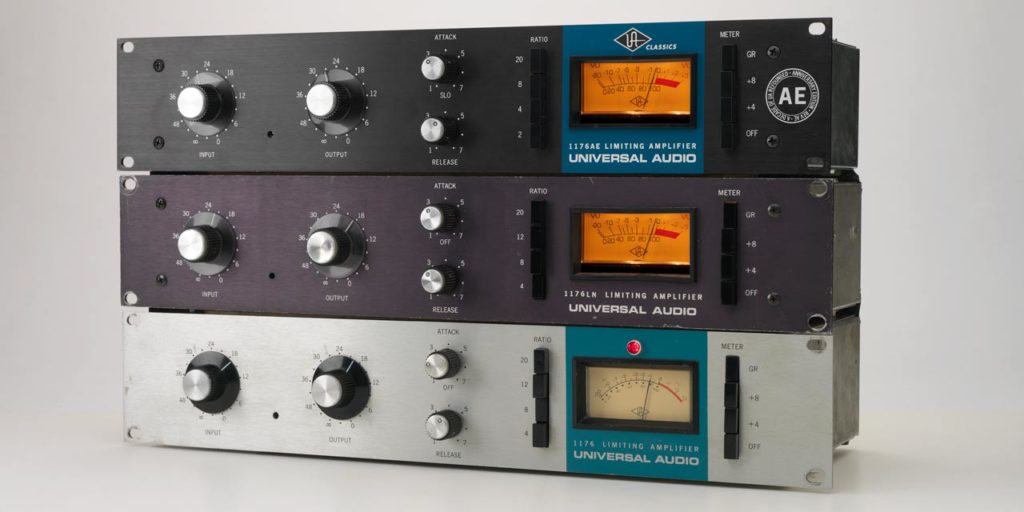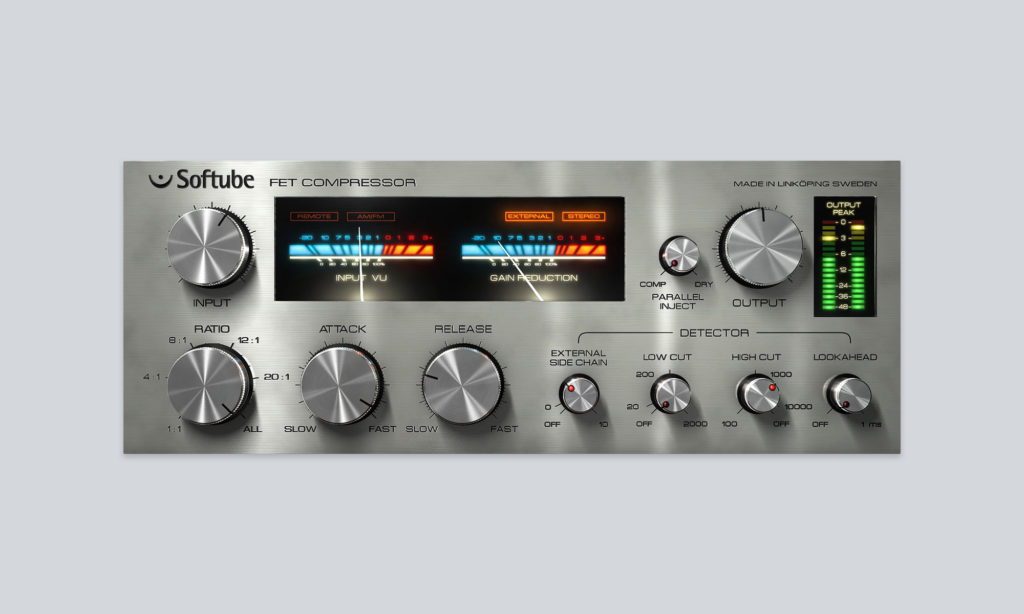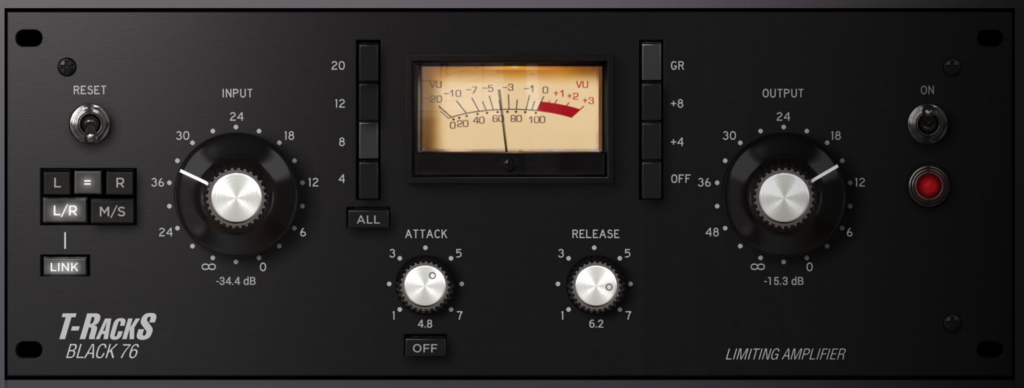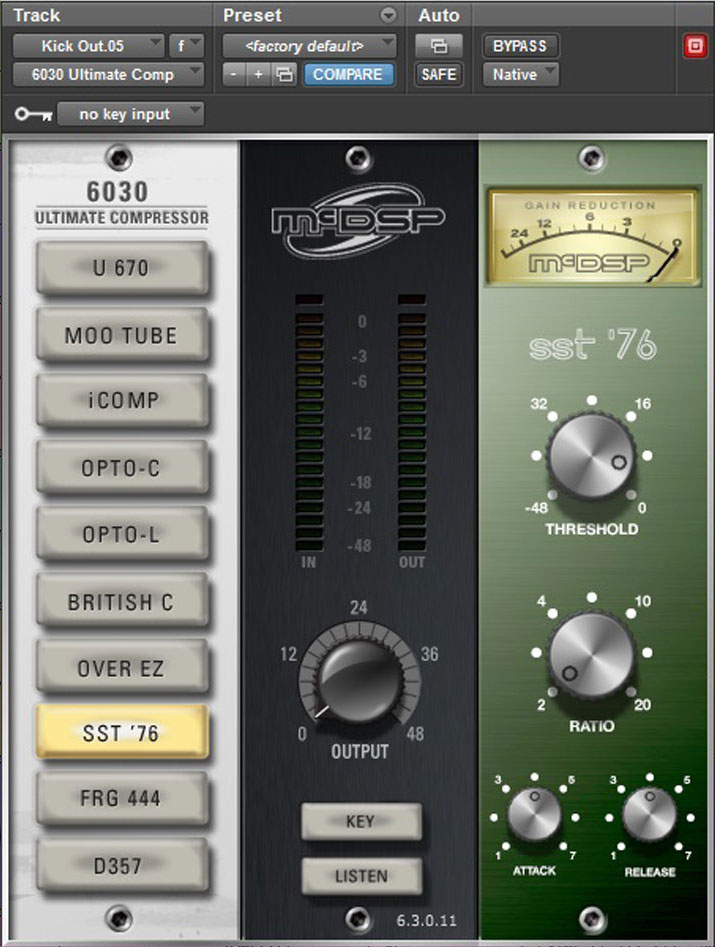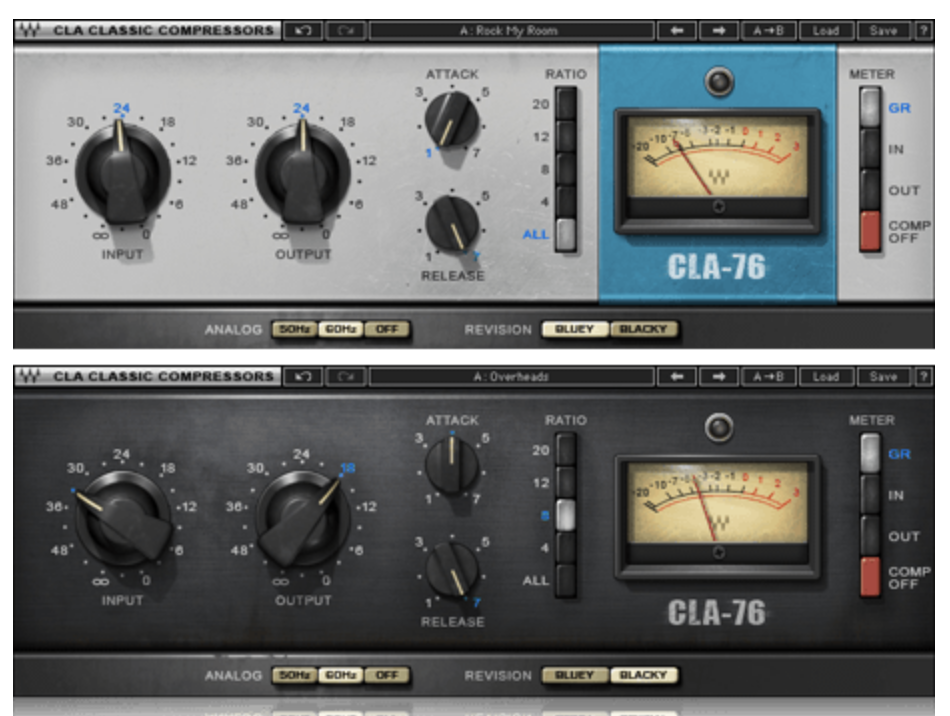The Definitive 1176 Compressor Plugin Roundup
The 1176 is arguably one of the most popular compressors of all time. Known for its super-fast attack time and colorful tone, this iconic compressor has been used on countless hit records over the last 50 years.
While vintage and reissued hardware models can be found in studios across the globe, the 1176 is also one of the most frequently emulated hardware compressors. So before we break down the best 1176 plugins, let’s take a look at what made the original 1176 so special.
1176 Legacy
The 1176 was originally designed by Bill Putnam Sr. in 1968 as a solid-state alternative to his successful 176 tube compressor. Billed as a “true peak limiter with all transistor circuitry,” the 1176 quickly became a favorite among audio engineers for its ability to limit transients with lightning speed.
The original’s attack times ranged from a fast 800 µS to a near-instant 20 µS (.00002 seconds). The attack controls also featured an “off” setting, allowing you inject your tracks with the warm, rich sound of FET circuitry without engaging the compressor circuit. Release times ranged from 50 mS to 1.1 seconds.
Four push buttons allow you to select between four main ratio options: 4:1, 8:1, 12:1 and 20:1. However, engineers quickly discovered that they could push all four buttons simultaneously to create an even more punchy, aggressive, and distorted sound. This “All-buttons-in” or “British mode” has become a highly sought-after sound, especially for parallel compression.
Similar to the 176 tube limiter, the 1176 does not feature threshold controls. Instead, engineers control the input to drive the signal against a fixed threshold, and can compensate by adjusting the output control if needed.
Revisions
Bill Putnam’s original design from 1968 was dubbed “Rev A” and featured a silver faceplate with a blue stripe over the VU meter, earning these units the nickname “bluestripes”. Over the next year, Universal Audio made a few minor tweaks to the design with the “Rev A/B” and “Rev B” units.
Years later, in 1970, the 1176 saw several major changes. “Rev C” introduced new low noise circuitry, as well as a new feedback circuit to minimize distortion. These new all-black models earned the name “blackfaces”. UA then introduced a number of minor changes over the following years with the Rev D and Rev E designs.
In 1973, UA outfitted the Rev F models with an updated output amplifier featuring a new Class A/B push-pull design. The Rev G models made minor changes to the circuitry, while Rev H made several cosmetic improvements.
In 2000, Bill Putnam Jr. began reissuing the 1176LN, based on the blackface Rev E design.
Emulations
Now that you know why the 1176 is such an iconic piece of studio gear, let’s take a look at some of the plugins upholding its legacy today in the digital domain.
Most 1176 emulations are modeled after the Rev E “blackface” model that the Universal Audio reissue was based on, although some are designed after the more colorful Rev A. For the audio samples in this review, I’ll be using Rev E emulations wherever they are available.
While each of these emulations offers 1176-style compression, no two plug-ins produce the same sound, even with identical settings. In order for you to hear the sonic differences for yourself, the samples you’ll find below include examples of moderate bass guitar compression, aggressive drum bus compression, extreme parallel compression, and subtle mix bus compression with each plug-in.
Let’s start off with a closer look of my own personal top 3, followed by the other top-tier options, in no particular order. While this list strives to be as comprehensive as possible, if we missed a favorite of yours, feel free to tell us all about it in the comments below. Here we go:
UAD 1176LN Rev E
Winner: Best Straightforward 1176 Emulation
The UAD 1176 Rev E is available as part of the Classic Limiter Collection, which also includes emulations of the Rev A version, as well as UA’s rare 1176 40th Anniversary Edition.
These units model their respective designs down to the very last detail. You can turn the attack setting to “off” to give your signal that warm FET sound without affecting the dynamics, just like the original. This is also one of the only units that lets you go beyond “all-buttons-in” mode and experiment with different ratios by pushing in any combination of ratio buttons for far-out effects.
While this model doesn’t offer any new features, it does a great job of capturing the energy and sound of the original 1176 in a painstaking way.
Native Instruments VC 76
Winner: Best Value
The VC 76 offers the fast, punchy sound of the 1176 that you know and love with a host of handy new features. You can create pumping compression effects with the new side-chain input or dial in explosive parallel compression with the wet/dry knob.
The attack and release controls here retain the familiar 1-7 range. While there is no “off” setting on the attack knob, you can set the ratio to 1:1 to give your tracks that fat FET sound without applying any compression.
However, you may find it difficult to use at first, as the attack and release controls are backwards! On the original 1176, the attack and release knobs went from slow to fast as you turned them left to right, but on the VC 76, they go from fast to slow.
The VC 76 also features fully variable ratio controls for added versatility. Although the ratio options have been extended down to 1:1, they only go up to 16:1. Not only is there no 20:1 ratio, there’s no “all-buttons-in” mode, which was a big drawing point of the original.
At just $99, this is one of the most affordable and versatile options in the bunch.
Softube FET Compressor
Winner: Most Versatile
The Softube FET Compressor looks more like a vintage stereo than an 1176, but it sounds great and includes a number of useful upgrades.
The FET Compressor offers fully variable controls all the way down to a 1:1 ratio, with a dedicated “ALL” setting for “all-buttons-in” mode. Although the attack and release knobs are simply labeled “SLOW” and “FAST”, they follow the same settings as the original.
The FET Compressor is equipped with an all-new detector section for added versatility. An external side-chain option allows for pumping side-chain compression. Dedicated low cut and high cut filters allow you to control exactly which frequencies are being compressed.
The Lookahead controls can be used to make the FET Compressor even faster than the original 1176. By increasing the Lookahead time you can prevent the unwanted “crackling” sound when using extremely fast attack and release times.
The FET Compressor also features a wet/dry knob for parallel processing.
But perhaps the most interesting feature of the FET Compressor is its compatibility with Softube’s Console 1. Quickly and easily adjust any parameter with real tactile controls using Console 1.
5 More Top Options
IK Multimedia Black 76 Limiting Amplifier
The Black 76 Limiting Amplifier by IK Multimedia is a very straightforward emulation of the 1176LN Rev. E. While the only new features are stereo linking and mid-side processing, the Black 76 does a great job of emulating the signature 1176 sound. It’s also easily one of the most affordable options on the list.
McDSP SST’76
The SST’76 is available as part of McDSP’s 6030 Ultimate Compressor suite. This 500-series-style compressor uses a solid-state (SST) circuit model based on the 1176.
Unlike the original 1176, the SST’76 features a traditional threshold control. It features a fully variable ratio control from 2:1 to 20:1. However, there is no option for “all-buttons-in” mode. The addition of a key input allows for advanced side-chain compression techniques.
PSP FETpressor
The PSP FETpressor is probably the most hot-rodded emulation on the list. The first thing you’re likely to notice with this plug-in is the attack and release times.
With variable attack controls from .1 μs to 10 μs, the PSP FETpresssor is even faster than the original. It’s also capable of achieving slower, more subtle compression than the hardware units with a variable release control from 10 ms to 1 second.
The FETpressor also features a number of useful new features. A side-chain high-pass filter allows you to compress bass-heavy signals without burying the needle. Blend controls allow you to quickly and easily dial in punishing parallel compression, while stereo linking options allow you to compress stereo signals simultaneously or independently.
Slate Digital FG-116
The FG-116 is available as part of the Virtual Mix Rack from Slate Digital. This 500-series-style compressor is modeled after the 1176LN Rev. E, but Slate also offers emulations of vintage and modern bluestripe models.
Aside from the addition of a wet/dry knob for parallel processing, the FG-116 is almost identical to the original. The one exception being the ratio controls, which are limited to 4, 8, 12 and 20.
While the FG-116 may not be capable of “British” mode on its own, Slate offers a free compressor called The Monster that emulates the classic “all-buttons-in” extreme compression sound of the 1176.
Waves CLA-76
The CLA-76 is actually two compressors in one. With the flip of a switch, you can toggle between the Rev. A and Rev. E models. It also features “analog” controls for adding a realistic ground-hum at 50 Hz or 60 Hz.
This is one of the most unique-sounding emulations on the list and holds a special place in the hearts of many engineers as one of the first 1176 emulations available.
Honorable Mentions
Finally, there are a few other companies that deserve special mention for their 1176 emulations.
Klanghelm makes a versatile, affordable 1176 emulation called the MJUC, which features controls for drive, timbre, HPF, wet/dry and more. It also emulates two other famous hardware compressors!
Lindell Audio’s 7X-500 is actually based on a hardware clone of the original 1176, and offers a unique take on the classic sound.
Stillwell Audio’s The Rocket is one of the most affordable 1176 emulations on the market at just $49 (or $25 for Reaper users!)
U-he’s Presswerk is a full-blown dynamics toolkit with an array of advanced features. Although it’s based on the 1176, it’s barely recognizable with all of the extra bells and whistles.
Available as part of Yamaha’s Vintage Channel Strip collection, the Compressor 276 delivers classic FET-style compression with fully variable ratio controls, auto make-up gain, and a side-chain HPF.
No matter which of these plug-ins you choose, they all deliver the classic FET sound. Perfect for drums, bass and vocals, even used for bus processing and more—you can’t go wrong having a good 1176 (or three) at your disposal
Did we miss any plug-ins? What’s your favorite 1176 emulation? Tell us all about it in the comments.
Brad Pack is an award-winning audio engineer and writer based in Chicago, IL. He currently owns and operates Punchy Kick, a professional mixing and mastering studio that specializes in pop punk, emo, punk, grunge, and alternative music.
He has been helping artists connect with fans through emotionally resonant mixes, cohesive masters, and insightful guidance for over 10 years. Check out his website PunchyKick.com or say hi on Instagram @PunchyKick.
Please note: When you buy products through links on this page, we may earn an affiliate commission.







